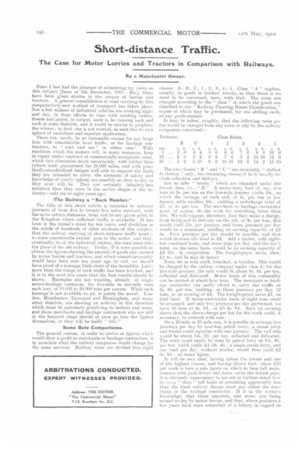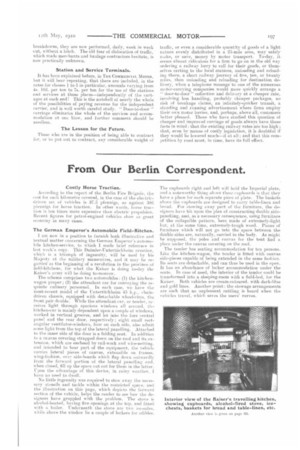Short-distance Traffic.
Page 8

Page 9

If you've noticed an error in this article please click here to report it so we can fix it.
The Case for Motor Lorries and Tractors in Comparison with Railways.
By a Manchester Owner.
Since I last had the pleasure of submitting my views on this subject [Issue of 5th December, 1907.-En.], there have been great strides in the output of lorries and tractors. A general consolidation of road carrying by this comparatively-new method of transport has taken place. Not a few makers of industrial vehicles are working night and day, in their efforts to cope with existing orders. Steam and petrol, in output, seem to be running neck and neck in some districts, and it would be unwise to prophesy the winner ; in fact, one is not wanted, as each has its own sphere of usefulness and superior application.
There can, surely, be no reasonable excuse for any large firm with considerable local traffic, or for haulage contractors, to " wait and see " in either case! With machines which the makers will, in many instances, keep in repair under contract at commercially-acceptable rates, which fact eliminates much uncertainty, with rubber tires (where used) guaranteed for 10,000 miles, and with practically-standardized designs well able to support the loads they are intended to carry, the elements of safety and knowledge of yearly upkeep are possibly as clear to-day as they ever will be. They are certainly infinitely-less nebulous than they were in the earlier stages of the industry—only six or eight years ago.
iThe Railway a "Back Number."
The title of this short article is intended to indicate journeys of from five to twenty-five miles outward, with the same return distances, from and to any given point in the Kingdom where sufficient traffic is available. It has been in the writer's mind for ten years, and doubtless in the minds of hundreds of other students of this subject, that the railway carrying of short-distance traffic most— to some considerable extent--pass to the motor, and that. eventually, in all the industrial centres, the road must take the place of the old railway. To-day, if it were possible to obtain the figures showing the amount of goods now carried by motor lorries and tractors, and which almost-mm tin bly would have been sent ten years ago by rail, we should have proof of a tonnage little short of the incredible. Little more than the fringe of such traffic has been touched, and it is in the next five years that the best results should be shown. Examples are not wanting, already, of single motor-haulage contracts, for five-mile to ten-mile runs each way, of 10,090 to 20,000 tons per annum. While such tonnage is not available to all, it points the moral. London, Manchester, Liverpool and Birmingham, and many other districts, are showing an activity in this direction which must he extremely gratifying to makers and users. and those merchants and haulage contractors who are still in the hesitant stage should at once go into the figures themselves, or they will be badly " left."
Some Rate Comparisons.
The general custom, in order to arrive at figures which would show a profit to merchants or haulage contractors, is to ascertain what the railway companies would charge. for the same services. Railway rates are divided into eight classes: A; B; C; 1; 2; 3; 4; 5. Class " A " applies, usually, to goods in traders' trucks, so that there is no need to be concerned, here, with that. The rates are charged according to the " class" in which the goods are classified in the " Railway Clearing House Classification,” copies of which may be purchased, for one shilling each,. at any goods station.
It may be taken, roughly, that the following rates per ton would be charged from any town or city by the railway companies concerned :—
The two classes " B " and " C " are invariably " station. to station " only; the remaining classes (I to 5) usually inelude collection and delivery.
Let us take " bricks," which are classified under the loeest class, i.e., " B." A motor-lorry load of, say, five tons at 2s. per ten on the live-mile journey yields 10s., to %%hick the cartage, ateach end, of Is. per ton (a low figure), adds another las., yielding a rail-charge total of
or ts. per ton. The merchant or haulage contractor must, of course, do the work for something lower than this. WP wilt suppose, therefore, that they make a charge, from brickyard to delivery on the job, of as. per ton; this would yield 15s. per journey, and three journeys per day would be a minimum, yielding an earning rapacity of I:2 5s. Four journeys per day should be possible, and that would increase the total to 1.:3. Add a trailer; with eightton combined loads, and three trips per day, and the day's_ total, on the same basis, would be an earning capacity of £3 in competition. The freight-payer saves, then, Li Is., and he may do better. Next, let us take cloth, bleached, in bundles. This would be charged by the railway company under class 4; for the five-mile journey, the rate would he about as. 4d. per ton, collected and delivered. Motor loads of this commodity can be carried of about four tons. The merchant or haulage contractor can easily afford to carry the traffic at 6s. 8d. per ton. yielding, on three journeys per day, 12 tons, or an earning of £4. The freight-payer saves Li, on that basis. If motor-and-trailer loads of eight tons could he arranged, and only two journeys per day performed, we have 16 tons at Os. 8d., or :e5 6s. 8d. Such an earning shows that the above charge per ton for the work could, if necessary, be reduced with ease. On a20-mile or 25-mile run, it is possible to arrange two journeys per day by four-ton petrol lorry; a steam lorry and trailer could equalize with one journey. The rail rate would be about 14s. 2d. per ton, collected and delivered. The work could easily be done by petrol lorry at 1 Is. 8d. per ten, whieh yields £1 13s. 4d.; a single steam lorry, and one load per day, without trailer, would thus yield £2Os. 8d. --no mean figure.
It will be seen that, having taken the lowest and one of the highest classless, and having shown that-since £10 per week is here a safe figure on which to base full maintenance with paid driver and mate—even the lowest pnys, it is obviously unnecessary to set out in further detail how in cro:,ry " class " full loads at something appreciably less than the fixed railway charge must pay either the merchant or the haulage contractor. It is in the writer's knowledge, that these amounts, and more, are being earned to-day by motor lorries, and that, where journeys a few years back were somewhat of a lottery in regard to breakdowns, they are now performed, daily, week in week out, without a hitch. The old fear of dislocation of traffic, which made merchants and haulage contractors hesitate, is now practically unknown.
Station and Service Terminals.
It has been explained before, in The COMMERCIAL MOTOR, but it will bear repeating, that there are included, in the rates for classes 1 to .5 in particular, amounls varying from 4s. 10d. per ton to 7s. per ton for the use of the stations and services at those places—independently of the cartages at each end? This is the nutshell of nearly the whole of the possibilities of paying revenue for the independent carrier, and is well worth careful study. " Door-to-door " carriage eliminates the whole of the services and accommodation at one blow, and further comment should be needless.
The Lesson for the Future.
Those who are in the position of being able to contract for, or to put out to contract, any considerable weight of traffic, or even a considerable quantity of goods of a light nature evenly distributed in a 25-mile area, may safely make, or save, money by motor transport. To-day, it. seems almost ridiculous for a firm to go on in the old way ordering a railway lorry to call for their goods, or themselves carting to the local stations, unloading and reloading there, a short railway journey of five, ten, or twenty miles, then unloading and reloading for destination de-livery, when a telephone message'to one of the numerous. motor-carrying companies would more quickly arrange a " door-to-door " collection and delivery at a. cheaper rate, involving less handling, probably cheaper packages, no risk of breakage claims, an infinitely-quicker transit, a standing and running advertisement where firms employ their own motor lorries, and, perhaps, above all, customers better pleased. Those who have studied this question of cheaper and improved carriage of goods always have these facts in mind ; that the existing railway rates are too high ; that, even by means of costly legislation, it is doubtful if they would be lowered much—if at all ; and that this nompetition by road must, in time, have its full effect.
























